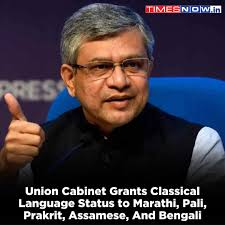Five languages, including marathi and bengali, receive classical status
Why in the news?
- The Union Cabinet approved classical language status for Marathi, Bengali, Assamese, Pali, and Prakrit.
- This decision fulfills a long-standing demand for Marathi’s classical status, pending since 2013, and aligns with the upcoming Maharashtra Assembly elections.
- The announcement for Bengali coincides with Durga Puja celebrations in West Bengal.
Historical Context:
- India previously recognized six classical languages: Tamil, Telugu, Malayalam, Kannada, Sanskrit, and Odia, with Tamil being the first in
- Prime Minister Narendra Modi expressed congratulations to speakers of these languages, highlighting the cultural significance of Marathi and Bengali literature.
Benefits and Impact:
- The Union Culture Ministry revised criteria for classical status through a Linguistics Experts Committee.
- The Education Ministry will provide benefits, including annual international awards, a Centre of Excellence for studies, and professional chairs at universities.
- This inclusion is expected to create employment opportunities in academia, research, and the preservation of ancient texts, contributing to job generation in archiving, translation, and digital media.
What Are Classical Languages?
- Definition: Established by the Government of India in 2004 to recognize languages with historical significance.
- Criteria for Status:
- Antiquity: Recorded history of 1,500–2,000 years.
- Literary Heritage: Possession of valuable ancient literature.
- Originality: Distinct literary tradition not borrowed from others.
- Discontinuity: Clear distinction from modern forms.
- Benefits:
- Financial assistance for establishing centres of excellence.
- Major awards for eminent scholars.
- Professional chairs for scholars in central universities.
Constitutional Provisions Related to Language:
- Eighth Schedule:
- Promotes progressive use of Hindi (Article 344).
- Duty of the Union to develop Hindi for all cultural elements (Article 351).
- Consists of 22 languages, initially including 14.
- Languages added: Sindhi (1967), Konkani, Manipuri, Nepali (1992), Bodo, Dogri, Maithili, Santhali (2004).
- Demand for inclusion of 38 more languages, influenced by socio-political factors.
- Language of the Union:
- Parliament: Article 120.
- State Legislature: Article 210.
- Official Language: Hindi in Devanagari script (Article 343).
- Regional Languages:
- States can adopt any official language (Article 345).
- Language for communication between states and the Union (Article 346).
- The President can recognize languages for population sections (Article 347).
- Special Directives:
- Protection of minority language rights (Article 29).
- Right to representation in any Union or State language (Article 350).
- Facilities for instruction in mother tongues (Article 350A).
- Appointment of a Special Officer for linguistic minorities (Article 350B).
Associated Article:
https://universalinstitutions.com/languages-added-in-the-8th-schedule-of-indian-constitution/




